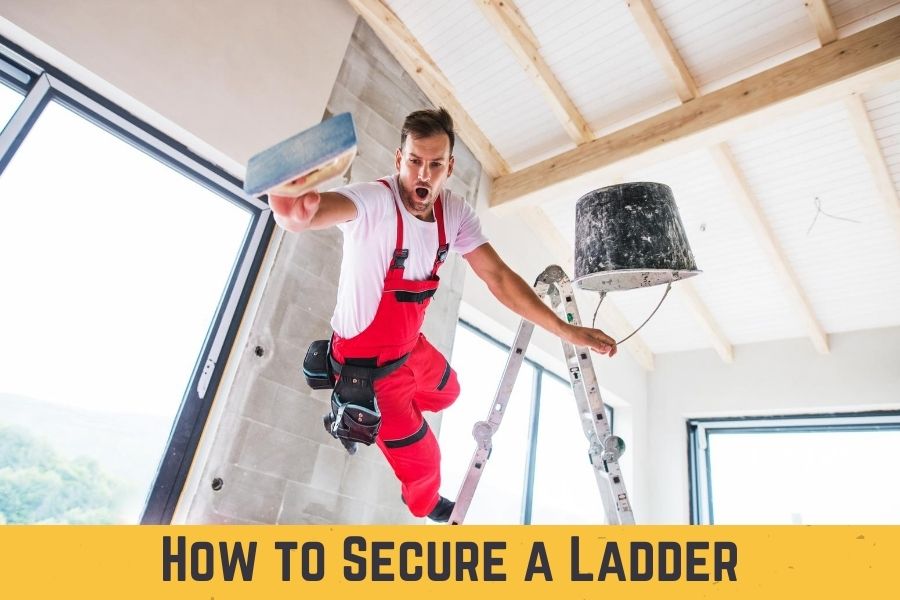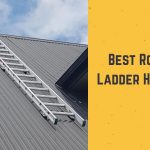You have to accept that in this world of safety, the primary cause of fatal injuries at the workplace result from falls and that it is also one of the deadliest killers at construction sites, especially to those people who don’t know how to secure a ladder.
Just to put you on the radar, there has been a total of 43% of fall injuries resulting from the improper use of a ladder in the last ten years.

And still, employees are reluctant to get trained on how to secure a ladder. Surprisingly, most employees will look at you in disbelief.
And because they know that you are just a safety manager or whatever title you have at the workplace, they will care less about the safety training you offer.

Honestly, ladders are quite simple tools that should be easy to use. Sadly ladders are proving to be the most complicated tools to use. Because if ladders were that straightforward to use, we wouldn’t have that scary stat above.
And in most cases, people don’t know how to secure a ladder. Ladder users always don’t set up their ladders at the correct angle, they don’t secure them, they don’t check whether their ladders are firm or not, and even worse, they never bother to look for a level surface when setting up their ladders.
Today, most companies have banned the use of ladders in cases where lifts can be used instead. It just highlights how careless we have been that we are never trusted to use ladders when there is an alternative.
But how should you secure a ladder?
Now, one of the myths I have heard a couple of times is that ladder instability is caused by people usually trying to protect themselves from the ladder falling back on them. And while this may be true to some extent, the truth is that the lateral movement is the most significant danger.
In this post, I’ll walk you through how to secure a ladder to make sure you are safe every time you are working on your ladder.
Let’s jump right in.
Table of Contents
How to Secure a Ladder
The Inspection
Before you do anything, you need to make sure that your ladder is in good condition. Carrying out a quick inspection on your ladder will help you ascertain whether or not your ladder is in perfect condition.
And if your ladder has two sections, it would help if you make sure that both parts are in good condition. Also, be sure to confirm that your rungs are not bent or broken before you proceed to work on your ladder.
You’d also want to make sure that your ladder does not have any grease or oil that could cause your ladder to slip and make you fall off.
Most ladder falls don’t just result from the ladder itself. In most cases, people fall off from the ladder, so it would help if you made sure that your ladder feet are both in place.
The Base
If you didn’t know, you should set up your ladder on an even firm surface that would prevent you from falling. Sadly, most people do not make sure that their ladders rest on level surfaces.
In most cases, people set up their ladders on mulch beds, in wet areas, or dug places. Even worse, some ladder users will go to the extent of setting up their ladders on smooth surfaces, which won’t provide stability needed to work on a ladder.
Let’s be clear and honest here: If you can’t mount your ladder on an even surface, then there is no point setting it up in the first place. It sounds a little harsh, but it’s your safety we are talking about here.
And that doesn’t mean that you should take several cinder blocks and mix them in the mud to create a base, because this will not offer you the stability you need either.
But let’s assume that you have set up your ladder on an even surface and that it is now stable. Also, the ladder is set to an angle of seventy-five degrees or in the ratio of 4:1. Lucky you, your a-frame is now open.
So does that mean that you are ready to go? Maybe yes, and perhaps no. This will depend because your focus should be to check what is at the base of your ladder before you get started.
Check if there are any objects, debris that could pose any risk or increase your chances of slipping and falling off the ground.
A cluttered ground is the most dangerous, especially when you are about to climb your ladder or to get off your ladder.
Finally, make sure that you are careful enough when getting down because there could be some potentially dangerous objects that could cause your injury. In short, don’t let your guard down just yet – remain watchful until you get off your ladder.
The Top
Now, that you are sure that you are on a level and stable ground, let’s move to the top and see how you can secure your ladder.
In any case of lateral movement, it will most probably occur not from the bottom or middle, but the top. So you need to know how to avoid this and prevent yourself from slipping and falling.
But how do you prevent this? It doesn’t matter whether or not you are on a level surface. The truth is that the weight you carry, as well as the motion, could still pose you to some danger. And I want to assume that you have not taken with you heavy tools along with you on the ladder.
The good news is that there are a couple of things you could do, and the most obvious one is to secure your ladder from the top so that you give these risks zero chances of occurring.
Don’t do this using the ladder lanyard. Also, don’t tie the ladder from the bottom or the middle.
Securing your ladder should be done at the top of the building you are working on. So make sure that you have tied your ladder to the building using a sturdy rope or use ladder hooks to help you with this.
And if you do this correctly, there are zero chances that your ladder will move. Sadly, you will not find something to secure your ladder at the top and there’s no need to fret about that – there is still an option.
If this is the case, make good use of your ladder stabilizer. A stabilizer will help you attach the top of the ladder, making the contact area of your ladder wider, thus much stable.
The 4:1 Ladder Ratio
The 4:1 ratio is a common rule, and I’m sure that you must have come across it when trying to search about ladder safety on Google, and that’s what we are going to discuss today.
And don’t get worried – there’s no school protractor we are going to use here – it’s just a simple concept.

The four to one ratio rule states that for every four feet high you climb, make sure that you move the base of your ladder one foot away from the building of operation, or rather the wall.
But you have another option, which requires you to position your ladder to an angle of seventy-five degrees, but this is not usually easy in most cases.
And even though the most proven and safest method is the four to one ratio rule, below is a formula that you can use to determine your ladder distance from the wall of operation.
This formula doesn’t have a name, but for now, we can name it “the arm length method.”
- Step 1: Position your ladder in front of your while it is leaning on the wall.
- Step 2: Stand on your toes, while making sure that your toes touch your ladder feet.
- Step 3: Try if you can reach your rungs more comfortably and directly while reaching out with your arms.
If you can do this, then that’s great, and it means that you have positioned your ladder in the right angle. Also, you need to be sure that the top foot rests against the wall before climbing the ladder.
If you can’t still reach the rung more comfortably and directly, then it means that your ladder is sloping too much. In this case, try moving the feet towards the wall and see if you can reach the rungs directly.
You should repeat this procedure until you are sure that you can reach the rungs directly using your arms.
In cases where you can reach the rungs, but your arms remain bent, it means that your ladder is so much upright, which is dangerous. To fix this, move your ladder feet away from the wall and try to see if it is now correct.
How to Secure Any Ladder
How to Secure a Ladder – Stepladder
First, it is essential to note that step ladders are in a variety of sizes, and the most common sizes among homeowners are sizes four, six and eight feet. But it the ladder size doesn’t matter – what matters are the following safety rules to help you secure your ladder:
- When you open a step ladder, you should check whether the two-hinged metal braces are straight and locked down.
- The biggest mistake you should never make is to set up your ladder on a cluttered ground. You need to make sure that the feet of your ladders hold firmly into the ground before climbing on it.
- In as much as it may be tempting to stand or sit at the top step of your ladder, please don’t. Most manufacturers will not recommend you to go past the third-highest step on your ladder.
- Don’t ever climb your ladder from the backside. Instead, always make sure that you are climbing up the front of your ladder. This rule, however, may not apply when you are using a two-person step ladder.
- When on top, be sure that your hips are within the vertical rails of the ladder. Going too far on the right or left side might increase your chances of slipping and falling.
- Also, make sure that you have removed all the tools you were using before lowering your ladder.
- You should never position a step ladder very close to the wall because this can result in the ladder toppling and falling.
- Maybe I don’t need to remind you of this, but it’s quite essential. Be sure that you are not standing on the paint shelf.
- Please make sure that you keep your ladder safely after using it, and away from children. If you need to take a break, store your ladder in a place out of reach of children to prevent any injuries that could occur as a result of children playing with the ladder.
How to Secure a Ladder – Extension Ladder
Extension ladders are your perfect match if you need to reach high ceilings in your home or even at your workplace. The only downside is that the higher you go with your ladder, the riskier it becomes. So I’d share some precautionary measures to help you secure your extension ladder. Let’s cut to the chase:
- If you want to extend your extension ladder, the first thing you need to do is to lay your ladder on the ground. The next step is to raise the top of your ladder and then walk it upright. Once you are confident that the ladder is in a vertical position, hold the rung, then lift the ladder a bit. Walk the ladder’s base away from the building of operation.
- When you are sure that your ladder is in a perfect position, take a rope and raise the telescopic section to any height you want. And make sure that the rungs have securely locked. Once that is done, tie the end of your rope to the lower rung.
- To make sure that you have set up your ladder in the right angle, be sure to use the four to one ratio rule or if you can, set the ladder to seventy-five degrees. For instance, if you are using a ladder that is sixteen feet, make sure that the base is four feet away from the building of operation.
- Additionally, make sure that the feet of your ladder hold the ground firmly. If one foot of your ladder appears unstable, please don’t begin to stack wood or mud beneath the foot. Instead, dig beneath the other foot to make sure that both feet are level.
- Never set up your extension ladder on a wet, or slippery surface as this would increase your chances of slipping and falling.
- You should never go past the third rung from the top of your ladder.
- Please make sure that you don’t set up your ladder near electricity sources to avoid electric shock.
- You should always face the ladder whether you are climbing the ladder or getting down from the ladder.
- If possible, please make sure that you have a belt to help you carry the tools you will use while up the ceiling. This will free up your hands, giving you the freedom to hold the ladder firmly when climbing or getting down.
- It is not advisable to always climb on the roof, and if you must, then make sure that your ladder can extend up to three feet above the roofline.
How to Secure a Ladder – Portable Ladders
- You need to make sure that you rest the top of your portable ladder against a surface that’s able to accommodate its weight. Also, you must never lean your ladder against your gutter, windowpane, window sash, or any place that is delicate and can easily break.
- If possible, be sure to use wall grips to minimize the chances of slipping and falling, especially when you lean your ladder against a slippery surface.
- Because ladders can be hazardous, it is crucial to make sure to guard the area you are operating your ladder. Also, you need to get someone to hold for you the ladder as you either climb on top, or you are getting down from the ladder.
- Make sure that you have secured your ladder from the top by either tying the top with a rope or wire to prevent toppling and falling when working.
- Be sure to use a stake or brace the base of your ladder before you begin working on your ceiling.
- You need to attach hooks from the top of your ladder rails.
- Please make sure that you are not resting the ladder on a rung because only the side rails can do that.
- It is also essential to make sure that the base of your ladder is secure before you start climbing to the top.
- When you are purchasing a portable ladder, make sure that you are buying one with non-slip feet for your safety.
- Before you climb too far, first test your ladder to ascertain that it is safe and secure.
Bottom Line
Even as we conclude this ultimate guide on how to secure a ladder, I must remind you about the top of your ladder because that’s where most ladder accidents result from.
There are possibilities that your ladder can wobble, or you could miss your footing, or worse lose your balance while at the top.
Be sure that you have secured your top and that the base is firm on an even surface. This will minimize the chances of ladder accidents that frequently occur.
And because you have this ultimate guide on how to secure a ladder, I’m sure that you will not fall victim to those who experience ladder accidents every time they use a ladder.
Good luck!

